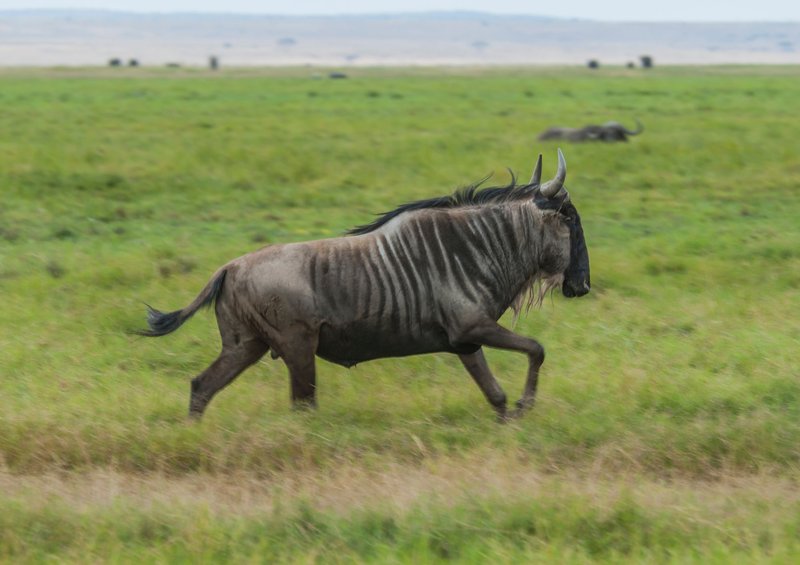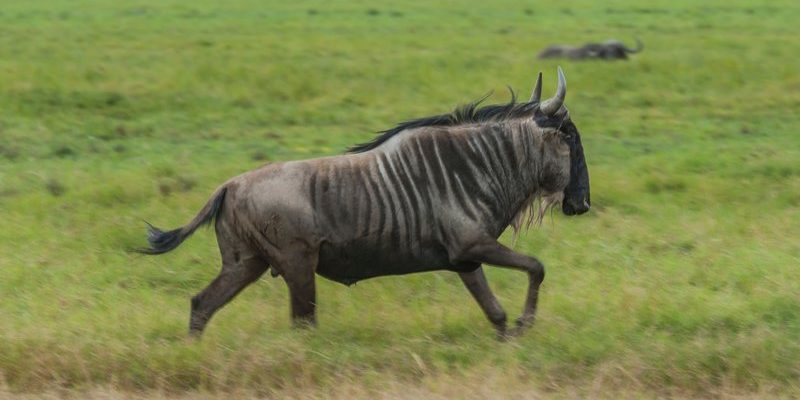
When you think about Africa’s wildlife, images of elephants, lions, and leopards might come to mind. However, the wildebeest deserves just as much attention. These remarkable creatures, also known as gnus, are famous for their incredible migration patterns and unique behaviors. Imagine being a part of a massive caravan of animals, all moving together across the vast plains, facing predators and the elements—this is the life of a wildebeest.
Wildebeests are large, herbivorous mammals that roam the grassy savannas of East and Southern Africa. They have a striking appearance: long, slender legs, a broad head, and distinctive curved horns. With their unique characteristics and fascinating social structures, they make for a captivating subject of study. They embody the essence of the African wilderness, showcasing nature’s resilience and the delicate balance of ecosystems.
Physical Characteristics
The wildebeest is an impressive animal, both in size and appearance. Adult males can weigh up to 600 pounds and stand around 4 to 5 feet tall at the shoulder. They have a shaggy mane, a long face, and large, expressive eyes that give them a distinct look. Females are typically smaller than males, weighing around 400 pounds. Their coats are a mix of gray and brown, providing excellent camouflage in their natural habitats.
One of the most striking features of the wildebeest is its horns. Males possess long, curved horns that can span up to 3 feet in width. These horns aren’t just for show—they play a crucial role in fights for dominance and mating rights. You might even say they are the wildebeest’s version of a crown, representing strength and status within herds.
Adaptations for Survival
Wildebeests have adapted well to the challenging environments they inhabit. Their long legs allow them to run at speeds of up to 50 miles per hour, which is vital for escaping predators like lions and hyenas. This speed comes in handy during their annual migration, where they travel hundreds of miles in search of fresh grazing grounds.
Another interesting adaptation is their dietary habits. Wildebeests are grazers, feeding primarily on grasses. Their digestive system is efficient at breaking down tough plant material, allowing them to thrive in areas where food might be scarce. This ability to consume low-quality grasses gives them an advantage during dry seasons when other herbivores might struggle.
Habitat and Distribution
Wildebeests are primarily found in the plains and open woodlands of East and Southern Africa. Countries like Tanzania, Kenya, and South Africa are home to large populations. These landscapes provide the perfect environment for grazing and migration. The wide-open spaces allow wildebeests to move freely, searching for new pastures to feed on.
During the rainy season, wildebeests gather in large numbers, forming herds that can consist of thousands of individuals. This congregation offers safety in numbers, a strategy that helps protect them from predators. When the grasses begin to dry up, the herds migrate to more fertile areas—this journey is one of the longest migrations of any land mammal, showcasing their resilience and adaptability.
The Great Migration
The annual migration of wildebeests is a breathtaking spectacle that attracts wildlife enthusiasts from all over the world. Each year, about 1.5 million wildebeests, along with hundreds of thousands of zebras, embark on this challenging journey across the Serengeti. It’s a dramatic and dangerous trek filled with obstacles, including rivers teeming with crocodiles and vast stretches of arid land.
The timing of the migration is dictated by the seasonal rains, which trigger the growth of fresh grass. Wildebeests are remarkably attuned to the environment, following the rains and ensuring they have enough food. This journey not only aids their survival but also plays a vital role in the ecosystem, as they help maintain the grasslands by grazing.
Social Structure
Wildebeest have a fascinating social structure. They live in large herds, led by a dominant male. This alpha male has the responsibility of protecting the herd and mating with females. Interestingly, females also have a strong social bond; they often form groups with other females, nurturing their young and sharing protective strategies.
These herds can sometimes reach up to 20,000 individuals. In such large groups, wildebeests exhibit a strong sense of community, relying on one another for safety against predators. They communicate using various vocalizations and body language, showcasing their complex social interactions.
Diet and Feeding Habits
As grazers, wildebeests primarily consume grasses, favoring young, tender shoots. Their diet plays a crucial role in shaping the savanna ecosystem. By grazing, they help control the growth of grasslands, which can promote biodiversity by allowing other plant species to flourish. Their feeding habits also attract other herbivores to the area, creating a dynamic ecosystem.
Wildebeests are particularly well-suited to their herbivorous lifestyle. They have flat molars designed for grinding grass, allowing them to efficiently process their food. In times of scarcity, they can adapt their diet to include shrubs and other vegetation, demonstrating their resourcefulness.
Reproduction and Life Cycle
The reproductive season for wildebeests is an exciting time. Females generally give birth to a single calf after a gestation period of about seven months. The timing of births is synchronized within the herd to maximize survival rates. Calves are born during the rainy season, aligning with the availability of fresh grass, ensuring they have enough nourishment.
Newborn wildebeest are surprisingly agile; they can stand and walk within minutes of birth. This ability is essential for their survival, as they must quickly join the herd to avoid predators. Mothers are very protective and attentive, often hiding their young in tall grass while they graze nearby.
Threats and Conservation
While wildebeests are well-adapted to their environment, they face several threats. Habitat loss due to farming and human encroachment poses a significant risk to their populations. Additionally, poaching and meat demand have contributed to declines in some areas. Climate change is also impacting their migratory patterns and food availability.
Conservation efforts are underway to protect wildebeests and their habitats. National parks and reserves provide safe havens for these animals, helping maintain viable populations. Efforts include anti-poaching initiatives and community-based conservation programs that engage local populations in protecting wildlife.
Interesting Facts
| Scientific Name: | Connochaetes |
| Size: | 4.5 to 5.5 feet tall at the shoulder |
| Weight: | 400 to 600 pounds |
| Diet: | Herbivore (primarily grasses) |
| Speed: | Up to 50 miles per hour |
| Lifespan: | 10 to 20 years in the wild |
| Habitat: | Savannas and plains of Africa |
The wildebeest is more than just a large animal roaming the African plains; it symbolizes the heart of the savanna ecosystem. With their unique adaptations, incredible migratory journeys, and intricate social structures, they remind us of the beauty and complexity of nature. As we learn more about these remarkable creatures, it becomes crucial to support conservation efforts and protect their habitats. After all, the survival of the wildebeest is a testament to the resilience of wildlife in the face of adversity.
FAQ
What do wildebeests eat?
Wildebeests are primarily herbivores, mainly consuming grasses. They prefer fresh, tender shoots and can adapt their diet to include shrubs and other vegetation during dry seasons. Their grazing habits significantly impact the savanna ecosystem, promoting biodiversity by helping control grass growth.
How long do wildebeests live?
In the wild, wildebeests typically live between 10 to 20 years, depending on environmental conditions and predation. Those in protected areas, like national parks, may live longer due to the absence of threats like poaching and habitat loss.
Why do wildebeests migrate?
Wildebeests migrate in search of fresh grazing pastures. Their movement is closely tied to seasonal rains, which trigger grass growth. This incredible journey, known as the Great Migration, helps ensure they have enough food and is essential for their survival.
Are wildebeests endangered?
Wildebeests are not currently classified as endangered, but they do face threats from habitat loss, poaching, and climate change. Conservation efforts are crucial to maintaining healthy populations and protecting their natural habitats.
Do wildebeests have any predators?
Yes, wildebeests have several natural predators, including lions, hyenas, and crocodiles. Their large herds provide some protection, as there is safety in numbers, making it more challenging for predators to target individual animals.
How do wildebeests communicate?
Wildebeests communicate through a variety of vocalizations and body language. They use grunts, snorts, and other sounds to convey different messages, such as alerting the herd to danger or coordinating movement within the group.
What role do wildebeests play in the ecosystem?
Wildebeests play a vital role in their ecosystems by grazing on grasses, which helps maintain the balance of the savanna. Their migration stimulates plant growth and provides food for other herbivores, contributing to a diverse and healthy environment.
Can wildebeests swim?
Yes, wildebeests are capable swimmers! During their migrations, they often need to cross rivers, like the Mara River, which can be both dangerous and challenging due to swift currents and lurking crocodiles. Their swimming ability helps them navigate these obstacles, though caution is always necessary.
How can I help protect wildebeests?
You can help protect wildebeests by supporting wildlife conservation organizations, spreading awareness about their plight, and promoting sustainable practices. Visiting national parks responsibly also contributes to funding conservation efforts, helping ensure these incredible animals continue to thrive.
Are all wildebeests the same species?
No, there are two main species of wildebeest: the black wildebeest and the blue wildebeest. The black wildebeest has striking, curved horns and a more solitary nature, while the blue wildebeest is known for its larger herds and migration patterns. Both species share some similarities but differ in behavior and habitat preferences.

